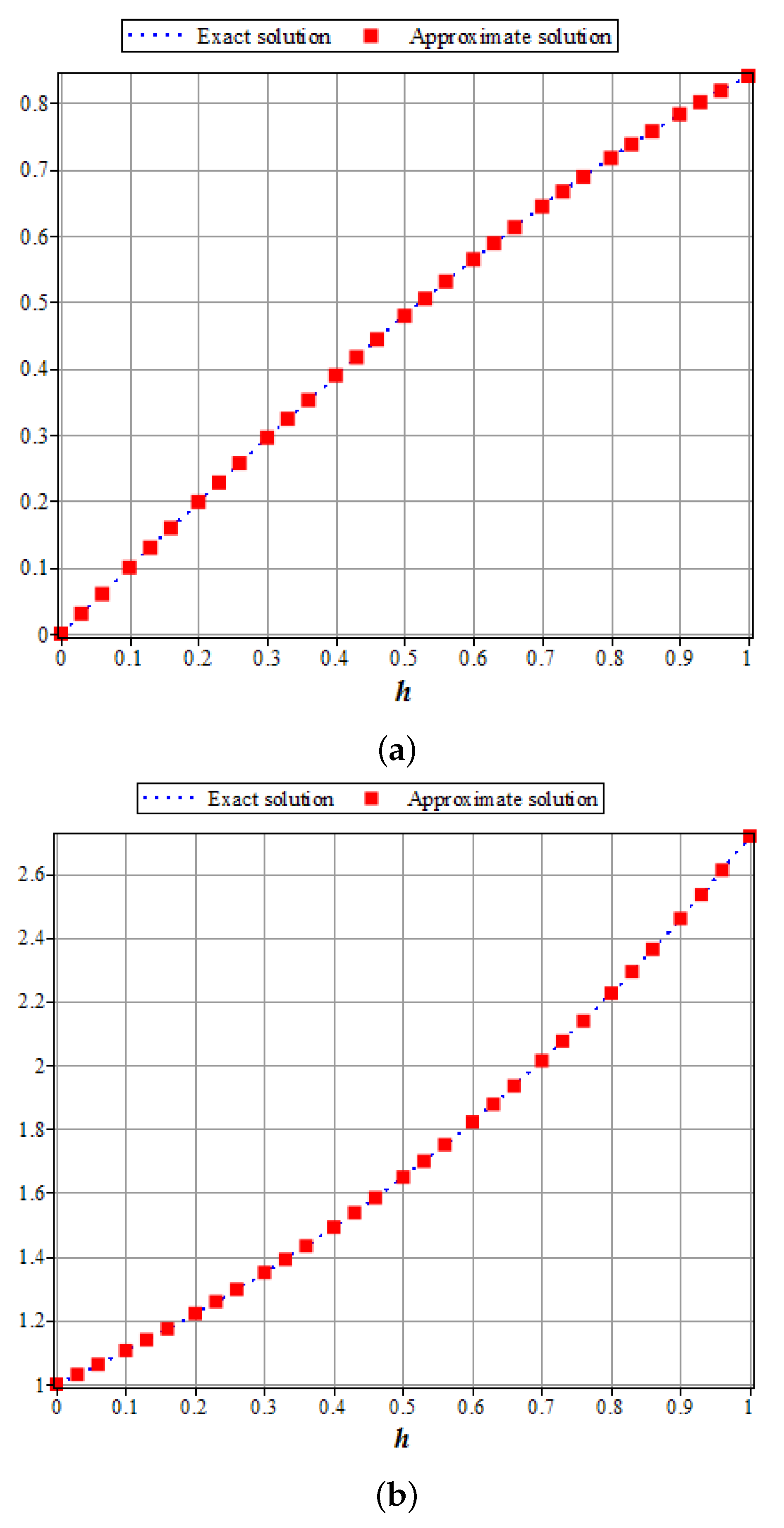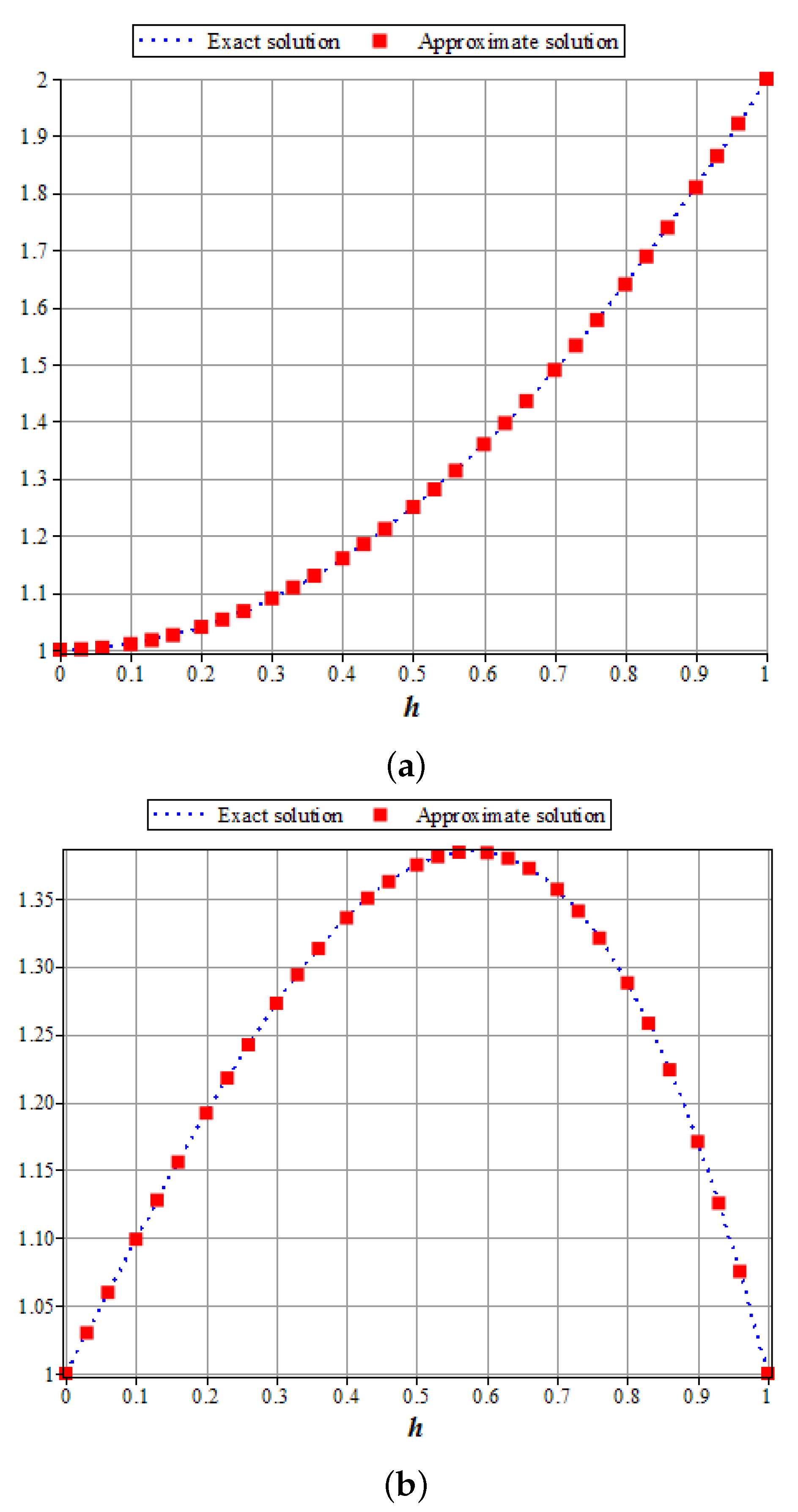Symmetric Bernstein Polynomial Approach for the System of Volterra Integral Equations on Arbitrary Interval and Its Convergence Analysis
Abstract
1. Introduction
2. The Proposed Approach
Bernstein’s Approximation for the VIEs of the First Kind
3. Hyers–Ulam Stability and Convergence Analysis
4. Numerical Examples
5. Conclusions
Author Contributions
Funding
Institutional Review Board Statement
Informed Consent Statement
Data Availability Statement
Acknowledgments
Conflicts of Interest
References
- Akbar, M.; Nawaz, R.; Sumbal, A.; Baleanu, D.; Nisar, K.S. Analytical Solution of System of Volterra Integral Equations Using OHAM. J. Math. 2020, 2020, 8845491. [Google Scholar] [CrossRef]
- Mutaz, M. Biorthogonal-Wavelet based method for numerical solution of Volterra integral equations. Entropy 2019, 11, 1098–1099. [Google Scholar]
- Gu, Z. Piecewise spectral collocation method for system of Volterra integral equations. Adv. Comput. Math. 2017, 43, 385–409. [Google Scholar] [CrossRef]
- Farshid, M. Numerical computational solution of the linear Volterra integral equations system via rationalized Haar functions. J. King Saud Univ. Sci. 2010, 22, 265–268. [Google Scholar]
- Niyazi, S.; Suayip, Y.; Mustafa, G. A collocation approach for solving systems of linear Volterra integral equations with variable coefficients. Comput. Math. Appl. 2011, 62, 755–769. [Google Scholar]
- Wei, J.; Zhong, C. Solving a system of linear Volterra integral equations using the new reproducing kernel method. Appl. Math. Comput. 2013, 219, 10225–10230. [Google Scholar]
- Navid, S.O.R.; Emran, T. The spectral method for solving systems of Volterra integral equations. J. Appl. Math. Comput. 2012, 40, 477–497. [Google Scholar]
- Masouri, Z.; Baboliana, E.; Hatamzadeh-Varmazyar, S. An expansion-iterative method for numerically solving Volterra integral equation of the first kind. Comput. Math. Appl. 2010, 59, 1491–1499. [Google Scholar] [CrossRef][Green Version]
- Sorkun, H.H.; Salih, Y. Approximate solutions of linear Volterra integral equation systems with variable coefficients. Appl. Math. Model. 2010, 34, 3451–3464. [Google Scholar] [CrossRef]
- Berenguer, M.I.; Gámez, D.A.I.; Galán, M.R.; Pérez, M.S. Biorthogonal systems for solving Volterra integral equation systems of the second kind. J. Comput. Appl. Math. 2007, 235, 1875–1883. [Google Scholar] [CrossRef]
- Armand, A.; Gouyandeh, Z. Numerical solution of the system of Volterra integral equations of the first kind. Int. J. Ind. Math. 2014, 1, IJIM-00310. [Google Scholar]
- Katani, R.; Shahmorad, S. Block by block method for the systems of nonlinear Volterra integral equations. Appl. Math. Model. 2010, 34, 400–406. [Google Scholar] [CrossRef]
- Aminikhah, H.; Biazar, J. A new analytical method for solving systems of Volterra integral equations. Int. J. Comput. Math. 2010, 87, 1142–1157. [Google Scholar] [CrossRef]
- Yang, L.H.; Shen, J.H.; Wang, Y. The reproducing kernel method for solving the system of the linear Volterra integral equations with variable coefficients. J. Comput. Appl. Math. 2012, 236, 2398–2405. [Google Scholar] [CrossRef]
- Sidorov, D.N. Solvability of Systems of Volterra Integral Equations of the First Kind with Piecewise Continuous Kernels. Izv. Vyss. Uchebnykh Zaved. Mat. 2011, 1, 62–72. [Google Scholar] [CrossRef]
- Jafariana, A.; Measoomy, S.N.; Abbasbandyb, S. Artificial neural networks based modeling for solving Volterra integral equations system. Appl. Soft Comput. 2014, 1, 1568–4946. [Google Scholar] [CrossRef]
- Bownds, J.M.; Cushing, J.M. Some stability theorems for systems of volterra integral equations. Appl. Anal. 2011, 5, 65–77. [Google Scholar] [CrossRef]
- Biazar, J.; Ebrahimi, H. Chebyshev wavelets approach for nonlinear systems of Volterra integral equations. Comput. Math. Appl. 2012, 63, 608–616. [Google Scholar] [CrossRef]
- Biazar, J.; Eslami, M. Modified HPM for solving systems of Volterra integral equations of the second kind. J. King Saud Univ. Sci. 2013, 23, 35–39. [Google Scholar] [CrossRef]
- Bhattacharya, S.; Mandal, B.N. Use of Bernstein Polynomials in Numerical Solutions of Volterra Integral Equations. Appl. Math. Sci. 2008, 36, 1773–1787. [Google Scholar]
- Hesameddinia, E.; Shahbazi, M. Solving multipoint problems with linear Volterra Fredholm integro-differential equations of the neutral type using Bernstein polynomials method. Appl. Numer. Math. 2019, 136, 122–138. [Google Scholar] [CrossRef]
- Hashemizadeh, E.; Kravchenko, O.V.; Mahmoudi, F.; Karimi, A. Numerical Solution of Non-linear Fredholm-Volterra Integral Equations Via Airfoil Polynomials with Error Analysis. J. Math. Anal. 2020, 11, 44–53. [Google Scholar]
- Rivlin, T.J. An Introduction to the Approximation of Functions; Dover Publications: Mineola, NY, USA, 1969. [Google Scholar]
- Basit, M.; Khan, F. An effective approach to solving the system of Fredholm integral equations based on Bernstein polynomial on any finite interval. Alex. Eng. J. 2022, 61, 2611–2623. [Google Scholar] [CrossRef]
- Miclaus, D. The generalization of the Bernstein approximation on any finite interval. Georgian Math. J. 2017, 24, 447–453. [Google Scholar] [CrossRef]
- Gu, Z. Hyers-Ulam Stability of Fredholm integral equations. Math. Aeterna 2015, 2, 257–261. [Google Scholar]



| h | Absolute Error for | Absolute Error for | ||
|---|---|---|---|---|
| 0 | ||||
| 0.1 | ||||
| 0.2 | ||||
| 0.3 | ||||
| 0.4 | ||||
| 0.5 | ||||
| 0.6 | ||||
| 0.7 | ||||
| 0.8 | ||||
| 0.9 | ||||
| 1 | ||||
| h | Absolute Error for | Absolute Error for | ||
|---|---|---|---|---|
| 0 | ||||
| 0.1 | ||||
| 0.2 | ||||
| 0.3 | ||||
| 0.4 | ||||
| 0.5 | ||||
| 0.6 | ||||
| 0.7 | ||||
| 0.8 | ||||
| 0.9 | ||||
| 1 | ||||
| h | Absolute Error for | Absolute Errors for | ||
|---|---|---|---|---|
| 0 | ||||
| 0.2 | ||||
| 0.4 | ||||
| 0.6 | ||||
| 0.8 | ||||
| 1.0 | ||||
| 1.2 | ||||
| 1.4 | ||||
| 1.6 | ||||
| 1.8 | ||||
| 2 | ||||
Publisher’s Note: MDPI stays neutral with regard to jurisdictional claims in published maps and institutional affiliations. |
© 2022 by the authors. Licensee MDPI, Basel, Switzerland. This article is an open access article distributed under the terms and conditions of the Creative Commons Attribution (CC BY) license (https://creativecommons.org/licenses/by/4.0/).
Share and Cite
Abdul Karim, S.A.; Khan, F.; Basit, M. Symmetric Bernstein Polynomial Approach for the System of Volterra Integral Equations on Arbitrary Interval and Its Convergence Analysis. Symmetry 2022, 14, 1343. https://doi.org/10.3390/sym14071343
Abdul Karim SA, Khan F, Basit M. Symmetric Bernstein Polynomial Approach for the System of Volterra Integral Equations on Arbitrary Interval and Its Convergence Analysis. Symmetry. 2022; 14(7):1343. https://doi.org/10.3390/sym14071343
Chicago/Turabian StyleAbdul Karim, Samsul Ariffin, Faheem Khan, and Muhammad Basit. 2022. "Symmetric Bernstein Polynomial Approach for the System of Volterra Integral Equations on Arbitrary Interval and Its Convergence Analysis" Symmetry 14, no. 7: 1343. https://doi.org/10.3390/sym14071343
APA StyleAbdul Karim, S. A., Khan, F., & Basit, M. (2022). Symmetric Bernstein Polynomial Approach for the System of Volterra Integral Equations on Arbitrary Interval and Its Convergence Analysis. Symmetry, 14(7), 1343. https://doi.org/10.3390/sym14071343






